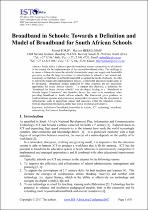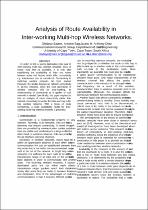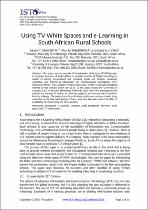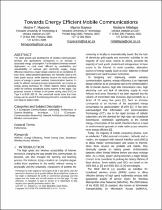 ResearchSpace
ResearchSpace
Broadband in schools: towards a definition and model of broadband for South African schools
JavaScript is disabled for your browser. Some features of this site may not work without it.
- ResearchSpace
- →
- Research Publications/Outputs
- →
- Conference Publications
- →
- View Item
| dc.contributor.author |
Ford, Merryl

|
|
| dc.contributor.author |
Herselman, Martha E

|
|
| dc.date.accessioned | 2017-10-17T10:30:55Z | |
| dc.date.available | 2017-10-17T10:30:55Z | |
| dc.date.issued | 2017-05 | |
| dc.identifier.citation | Ford, M. and Herselman, M.E. 2017. Broadband in schools: towards a definition and model of broadband for South African schools. In: ISTAfrica 2017 Conference, Windhoek, Namibia, 31 May - 2 June 2017 | en_US |
| dc.identifier.isbn | 978-1-905824-56-4 | |
| dc.identifier.uri | http://www.ist-africa.org/Conference2017/files/IST-Africa2017_AdvanceProgramme.pdf | |
| dc.identifier.uri | http://hdl.handle.net/10204/9669 | |
| dc.description | ISTAfrica 2017 Conference, 31 May - 2 June 2017, Windhoek, Namibia. | en_US |
| dc.description.abstract | South Africa is about to provide broadband internet connectivity to all schools in the country via the implementation of the national broadband policy. The challenge is to ensure a balance between the schools’ demand-side usage and supply-side bandwidth provision, so that the large investment in infrastructure to schools is not wasted and, conversely, so that there is sufficient bandwidth to support the needs of schools. In order to inform the bandwidth implementation process, a bandwidth allocation model needs to be developed. Broadband models employed by other countries are not necessarily appropriate for South African schools. To support this objective, a definition for “broadband for South African schools” was developed, leading to a “Broadband in Schools Impact Framework” that identifies factors that need to be considered when providing broadband to South African schools. The framework gives guidance to implementation agencies and government policymakers to ensure that the investment in infrastructure leads to appropriate impact and outcomes within the education system, from an educational perspective, rather than from a technology perspective. | en_US |
| dc.language.iso | en | en_US |
| dc.publisher | IST-Africa | en_US |
| dc.relation.ispartofseries | Workflow;19176 | |
| dc.subject | South African broadband internet connectivity | en_US |
| dc.subject | South African schools broadband | en_US |
| dc.subject | Broadband models | en_US |
| dc.subject | Broadband in schools impact framework | en_US |
| dc.subject | SA connect | en_US |
| dc.title | Broadband in schools: towards a definition and model of broadband for South African schools | en_US |
| dc.type | Conference Presentation | en_US |
| dc.identifier.apacitation | Ford, M., & Herselman, M. E. (2017). Broadband in schools: towards a definition and model of broadband for South African schools. IST-Africa. http://hdl.handle.net/10204/9669 | en_ZA |
| dc.identifier.chicagocitation | Ford, Merryl, and Martha E Herselman. "Broadband in schools: towards a definition and model of broadband for South African schools." (2017): http://hdl.handle.net/10204/9669 | en_ZA |
| dc.identifier.vancouvercitation | Ford M, Herselman ME, Broadband in schools: towards a definition and model of broadband for South African schools; IST-Africa; 2017. http://hdl.handle.net/10204/9669 . | en_ZA |
| dc.identifier.ris | TY - Conference Presentation AU - Ford, Merryl AU - Herselman, Martha E AB - South Africa is about to provide broadband internet connectivity to all schools in the country via the implementation of the national broadband policy. The challenge is to ensure a balance between the schools’ demand-side usage and supply-side bandwidth provision, so that the large investment in infrastructure to schools is not wasted and, conversely, so that there is sufficient bandwidth to support the needs of schools. In order to inform the bandwidth implementation process, a bandwidth allocation model needs to be developed. Broadband models employed by other countries are not necessarily appropriate for South African schools. To support this objective, a definition for “broadband for South African schools” was developed, leading to a “Broadband in Schools Impact Framework” that identifies factors that need to be considered when providing broadband to South African schools. The framework gives guidance to implementation agencies and government policymakers to ensure that the investment in infrastructure leads to appropriate impact and outcomes within the education system, from an educational perspective, rather than from a technology perspective. DA - 2017-05 DB - ResearchSpace DP - CSIR KW - South African broadband internet connectivity KW - South African schools broadband KW - Broadband models KW - Broadband in schools impact framework KW - SA connect LK - https://researchspace.csir.co.za PY - 2017 SM - 978-1-905824-56-4 T1 - Broadband in schools: towards a definition and model of broadband for South African schools TI - Broadband in schools: towards a definition and model of broadband for South African schools UR - http://hdl.handle.net/10204/9669 ER - | en_ZA |








